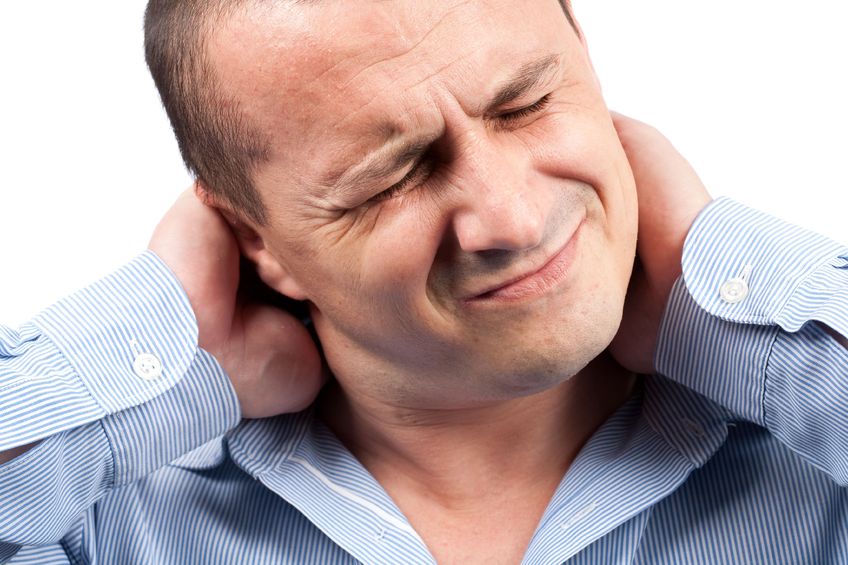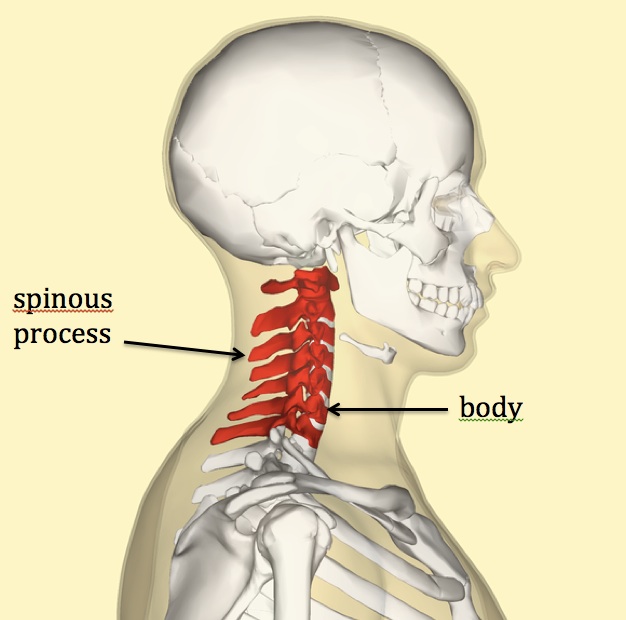Neck Pain

Tips to Prevent Neck Pain
- Standing posture should align the ears, shoulders, hips, side of the knee, and ankle bone when looked at from the side.
- When sitting at a desk, the low back should be supported, and the natural curve maintained. This will force the chest and rib cage upward and make it easier to maintain the proper C-spine posture.
- Place the computer monitor directly in front of your seat and at eye level.
- The head usually weighs 10 – 15 lbs.
- If you have neck pain, seek treatment from a Physical Therapist to restore normal function.
Recovering from Neck Pain
If you suffer from regular neck pain, you know firsthand the pain caused by spasms as well as the loss of motion and strength in the neck and upper extremities. Common everyday activities can be difficult. Physical Therapists help eliminate these symptoms by administering a thorough rehabilitation program.
Neck pain is extremely common. In fact, two-thirds of the population will experience neck pain at least once in their lifetime.[1] It is estimated that 46 million Americans suffered from neck pain in 2010.[2] The causes of neck pain are numerous. Injury/trauma, poor postural positioning, and even the natural aging process can all play a role in effecting neck pain.
Overview of Neck Anatomy
A quick overview of neck anatomy can help demonstrate the chief causes of neck pain. The neck or Cervical spine is the upper part of the spinal column, extending from the upper back to the base of the skull. In addition to supporting the head, it also facilitates blood flow to the brain and houses the spinal cord. The Cervical spine consists of 7 vertebrae.
The posterior (back) aspect of the vertebrae consists of the spinous process. These are the bony projections that are felt when you touch the back of your neck, and they are for muscle attachments and protection. Adjacent to the spinous process on either side are the joints (facet joints) that articulate with the vertebrae that is above and below.
The anterior (front) aspect of the vertebrae is called the body. It is separated from the others by a fluid filled disc. The disc acts as a shock absorber and helps to dissipate the different forces that are encountered during everyday activities.
The bones are held together by “leather-like” ligaments and a dense ligamentous capsule (bag like structure) that engulfs the facet joints. When two vertebrae are placed one on top of the other, a small opening is formed called a foreamen. This “hole” allows the nerves to pass outward from the spinal cord and into the Brachial Plexus. The bones are moved by various layers of Cervical spine paraspinal muscles and the larger muscles that can be seen when you look into a mirror.
Musculoskeletal Causes of Neck Pain
Muscle spasms, trigger points, and bone spurs can cause extreme discomfort to the neck. These painful conditions can be caused by damage or stress to the cervical vertebrae due to trauma, poor posture and even aging.
Trauma – An injury to one of these structures can range from a Cervical spine vertebrae fracture to a muscular strain. A trauma, such as an accident or fall, the muscle may contract violently to protect the spine. Sudden movements of the C-spine elicit a forceful, reflexive contraction of the involved muscles and can cause internal damage. This is believed to cause muscle spasm and trigger points (“knots” in the muscle).
Improper posture – Over time, improper posture can lead to muscular and joint pain. Fatigue sets after a specific joint or muscle is held in one place for too long. Fatigued muscles can spasm and cause a great deal of pain in the C-spine area.
Aging – During the natural aging process, the bony areas of the spine can begin to “break down.” If this occurs, the shape of the bones and joints of the spine can change. The soft tissue that holds the spine together adapts to the changing shape of the spine and can begin to shorten or elongate.
The altered tissue can limit motion in the neck, actually pulling on the bone with enough force to cause a bony adaption to the force and produce more bone. This excess bone forms an osteophyte or bone spur. If this bone spur extends and “touches” a structure that is not designed to have pressure placed on it (e.g. nerve roots), then it can cause a significant amount of pain to develop in the neck and upper extremities.
Effective Methods of Neck Treatment
Physical Therapists successfully treat neck pain on a daily basis. They provide a thorough rehabilitation program that addresses all aspects of the possible causes of the pain including
- modalities to stimulate blood flow and reduce pain;
- manual techniques to mobilize soft tissues and enhance range of motion;
- manual manipulation of trigger points and muscles that are in spasm to enhance significant blood flow and help to reduce the pain.
Once the pain is reduced, the patient will be able to move more “freely.” Without the pain, abnormal motions should be reduced significantly, and muscles should work more efficiently.
The Physical Therapist will prescribe a series of therapeutic exercises that will aide in the restoration of strength, endurance, proprioception, and motion of the neck. By performing exercises that incorporate the entire core, the patient should be adequately strengthened to assume proper posture and maintain proper posture for prolonged periods of time both standing and sitting.
Additionally, the Physical Therapist will educate the patient with proper ergonomics involved with daily life activities. As symptoms reduce, the patient should enjoy normal function and be able to return to their entire daily activities.
[1] Binder AI. Cervical spondylosis and neck pain. BMJ. 2007;334:527-531.[2] According to the CDC’s “Summary Health Statistics for U.S. Adults: National Health Interview Survey, 2010,” 15% of Americans reported suffering from neck pain. Based on the United States Census Bureau, the estimated US population size in 2010 was 313,914,040, so fifteen percent equals 46,312,126.


























my 27 years son got affected by tinnitus ,we found out he has a disc problem could that be cured?
could a disk problem on neck cause tinnitus